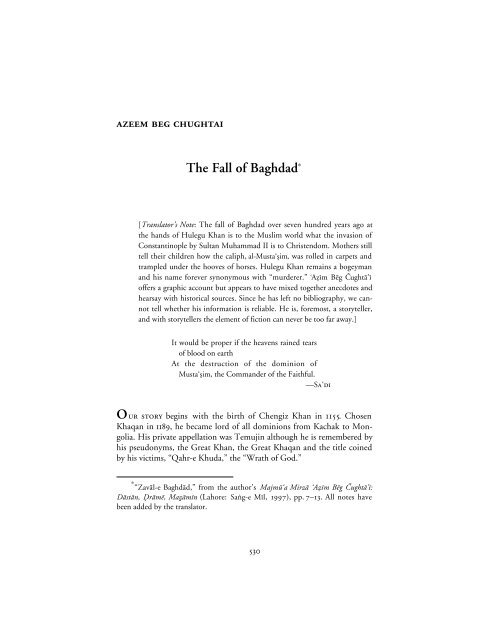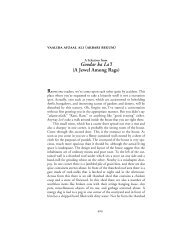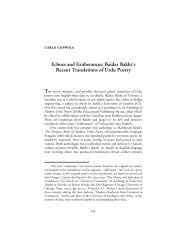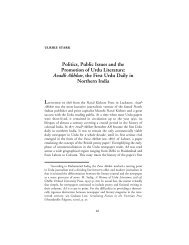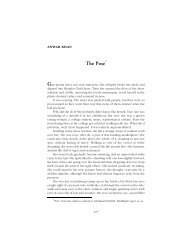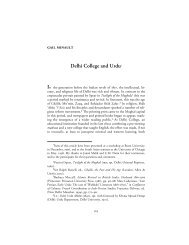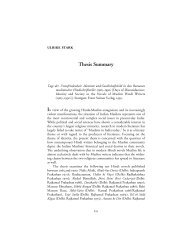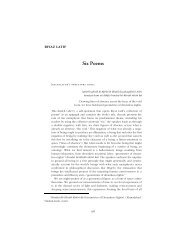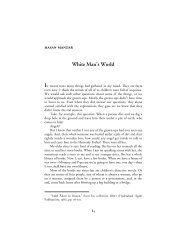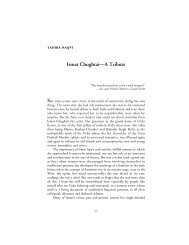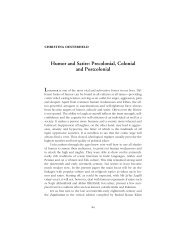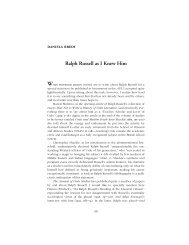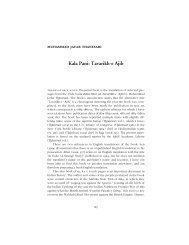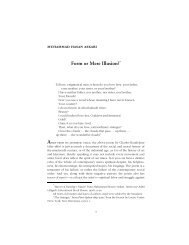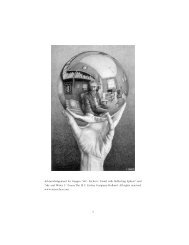The Fall of Baghdad - the Annual of Urdu Studies
The Fall of Baghdad - the Annual of Urdu Studies
The Fall of Baghdad - the Annual of Urdu Studies
Create successful ePaper yourself
Turn your PDF publications into a flip-book with our unique Google optimized e-Paper software.
AZEEM BEG CHUGHTAI<br />
<strong>The</strong> <strong>Fall</strong> <strong>of</strong> <strong>Baghdad</strong> ∗<br />
[Translator’s Note: <strong>The</strong> fall <strong>of</strong> <strong>Baghdad</strong> over seven hundred years ago at<br />
<strong>the</strong> hands <strong>of</strong> Hulegu Khan is to <strong>the</strong> Muslim world what <strong>the</strong> invasion <strong>of</strong><br />
Constantinople by Sultan Muhammad II is to Christendom. Mo<strong>the</strong>rs still<br />
tell <strong>the</strong>ir children how <strong>the</strong> caliph, al-Musta‘Ωim, was rolled in carpets and<br />
trampled under <strong>the</strong> hooves <strong>of</strong> horses. Hulegu Khan remains a bogeyman<br />
and his name forever synonymous with “murderer.” ‘A µm B®g ≤ught≥’µ<br />
<strong>of</strong>fers a graphic account but appears to have mixed toge<strong>the</strong>r anecdotes and<br />
hearsay with historical sources. Since he has left no bibliography, we cannot<br />
tell whe<strong>the</strong>r his information is reliable. He is, foremost, a storyteller,<br />
and with storytellers <strong>the</strong> element <strong>of</strong> fiction can never be too far away.]<br />
It would be proper if <strong>the</strong> heavens rained tears<br />
<strong>of</strong> blood on earth<br />
At <strong>the</strong> destruction <strong>of</strong> <strong>the</strong> dominion <strong>of</strong><br />
Musta‘Ωim, <strong>the</strong> Commander <strong>of</strong> <strong>the</strong> Faithful.<br />
—SA‘DI<br />
OUR STORY begins with <strong>the</strong> birth <strong>of</strong> Chengiz Khan in 1155. Chosen<br />
Khaqan in 1189, he became lord <strong>of</strong> all dominions from Kachak to Mongolia.<br />
His private appellation was Temujin although he is remembered by<br />
his pseudonyms, <strong>the</strong> Great Khan, <strong>the</strong> Great Khaqan and <strong>the</strong> title coined<br />
by his victims, “Qahr-e Khuda,” <strong>the</strong> “Wrath <strong>of</strong> God.”<br />
∗ “Zav≥l-e Baghd≥d,” from <strong>the</strong> author’s Majm∑‘a Mirz≥ ‘A µm B®g ≤ught≥’µ:<br />
D≥st≥n, ∆r≥m®, Ma¤≥mµn (Lahore: Sag-e Mµl, 1997), pp. 7–13. All notes have<br />
been added by <strong>the</strong> translator.<br />
530
AZEEM BEG CHUGHTAI • 531<br />
Abdul Latif, <strong>the</strong> famous Muslim historian, writes <strong>of</strong> his nation <strong>of</strong><br />
Mongols in <strong>the</strong>se words: “<strong>The</strong>ir men and <strong>the</strong>ir women fight in combat.<br />
<strong>The</strong> arrow is <strong>the</strong>ir main weapon and meat <strong>the</strong>ir staple food. No one is<br />
spared in <strong>the</strong>ir onslaught. <strong>The</strong>y will not even let <strong>the</strong> women and children<br />
get away.”<br />
Chengiz had no contact with <strong>the</strong> Islamic world but his kingdom<br />
shared a common border with <strong>the</strong> dominions <strong>of</strong> Khwarizm Shah. <strong>The</strong><br />
Muslims invited trouble when one <strong>of</strong> <strong>the</strong> Khwarizm’s governors rashly<br />
ordered <strong>the</strong> execution <strong>of</strong> some Mongol traders and <strong>the</strong> confiscation <strong>of</strong><br />
<strong>the</strong>ir goods.<br />
Chengiz wanted to establish friendly relations with <strong>the</strong> Khwarizm<br />
Shah. He sent an emissary, demanding to have <strong>the</strong> governor tried and<br />
punished. It was after a denial <strong>of</strong> justice and <strong>the</strong> murder <strong>of</strong> his emissary<br />
that <strong>the</strong> Mongol took to <strong>the</strong> sword. A million Mongols are said to have<br />
marched under his standards on <strong>the</strong> campaign against <strong>the</strong> most powerful<br />
<strong>of</strong> <strong>the</strong> Muslim princes. <strong>The</strong>y swarmed out <strong>of</strong> <strong>the</strong> Steppes and swept away<br />
everything before <strong>the</strong>m. Khwarizm Shah assembled an army <strong>of</strong> four hundred<br />
thousand to withstand <strong>the</strong> onslaught. 1 One after ano<strong>the</strong>r <strong>the</strong> towns,<br />
villages, Casbahs and fortresses were overrun; <strong>the</strong>ir populace subjected to<br />
rapine and slaughter. Vast tracts <strong>of</strong> land, once prosperous and beautiful,<br />
now lay in ruins. Except for corpses and piles <strong>of</strong> rubble, nothing<br />
remained.<br />
After leveling Khajand and slaughtering <strong>the</strong> inhabitants <strong>of</strong> Bokhara,<br />
Chengiz marched upon Samarkand. Samarkand was a unique city in <strong>the</strong><br />
Islamic empire. A London or Paris <strong>of</strong> its time, it was <strong>the</strong> capital <strong>of</strong> old<br />
Sogdiana and unrivaled in <strong>the</strong> entire world for its trade, industry and<br />
commerce. <strong>The</strong> citadel <strong>of</strong> Samarkand had a perimeter wall <strong>of</strong> three miles,<br />
manned by a garrison <strong>of</strong> one million. With such a large military presence,<br />
it is easy to imagine <strong>the</strong> immense scale <strong>of</strong> <strong>the</strong> town.<br />
Mongol troops besieged <strong>the</strong> capital. <strong>The</strong> siege was supported by <strong>the</strong><br />
mutiny <strong>of</strong> sixty thousand <strong>of</strong> its defenders who left <strong>the</strong> ramparts to join<br />
Mongol ranks, but Chengiz showed little sympathy with <strong>the</strong> turncoats<br />
and had <strong>the</strong>m executed. Bereft <strong>of</strong> hope, <strong>the</strong> imam and <strong>the</strong> qazis <strong>of</strong> <strong>the</strong> city<br />
1 In his <strong>The</strong> Decline and <strong>Fall</strong> <strong>of</strong> <strong>the</strong> Roman Empire, 6 vols. (London: David<br />
Campbell Publishers, 1993), Edward Gibbon writes that in <strong>the</strong> first battle <strong>the</strong><br />
Sultan lost 160,000 soldiers. Astonished by <strong>the</strong> multitude and valor <strong>of</strong> <strong>the</strong> Mongol<br />
troops, he withdrew his forces to defend frontier towns, but <strong>the</strong> Mongols<br />
pursued him and besieged <strong>the</strong> towns. Cf. vol. VI, p. 315.
532 • THE ANNUAL OF URDU STUDIES<br />
pleaded for a cessation <strong>of</strong> hostilities but <strong>the</strong>ir pleas were ignored. <strong>The</strong> city<br />
was ravaged and, except for some artisans and o<strong>the</strong>r laborers who<br />
amounted to fifty thousand, <strong>the</strong> entire populace was put to <strong>the</strong> sword. It<br />
is said that nine hundred and fifty thousand people perished. If <strong>the</strong><br />
destruction <strong>of</strong> a city <strong>of</strong> a million and <strong>the</strong> slaughter <strong>of</strong> nine hundred and<br />
fifty thousand <strong>of</strong> its inhabitants is not <strong>the</strong> “Wrath <strong>of</strong> God” <strong>the</strong>n what is<br />
After Samarkand and Bokhara, Chengiz Khan’s army turned towards<br />
Balkh. <strong>The</strong> inhabitants <strong>of</strong> Balkh had heard <strong>of</strong> <strong>the</strong> fate <strong>of</strong> Samarkand;<br />
fearing for <strong>the</strong>ir lives, <strong>the</strong>y decided not to put up a fight. <strong>The</strong>y sent emissaries<br />
instead, laden with gifts, to sue for peace. Chengiz Khan took <strong>the</strong><br />
gifts and seemingly accepted <strong>the</strong>ir terms. <strong>The</strong>n he lured <strong>the</strong> inhabitants<br />
outside <strong>the</strong> town for a census and <strong>the</strong>y were slaughtered as soon as <strong>the</strong>y<br />
had assembled. <strong>The</strong> town was burnt to <strong>the</strong> ground.<br />
After Balkh came Khiva’s turn. <strong>The</strong> population was slaughtered and<br />
<strong>the</strong> banks <strong>of</strong> <strong>the</strong> Oxus were breached to flood <strong>the</strong> town. Not a vestige was<br />
left <strong>of</strong> its existence.<br />
From Khiva, Chengiz proceeded to Nesa. Seventy thousand men,<br />
women and children were rounded up, bound, forced to lie down on <strong>the</strong><br />
ground and <strong>the</strong>n pierced with arrows. Next came Nishapur, which was<br />
Banu Tahir’s [<strong>The</strong> Tahirids] capital. In and around <strong>the</strong> capital city, seven<br />
million forty-seven thousand people were massacred. <strong>The</strong> city was leveled,<br />
its foundations ploughed and, to set an example, its soil was sown with<br />
barley. 2<br />
From here Chengiz rode towards Herat, inflicting upon it <strong>the</strong> same<br />
fate as its predecessors. <strong>The</strong> town was annihilated. One million six hundred<br />
thousand people were killed. Such was <strong>the</strong> devastation that when <strong>the</strong><br />
Mughals <strong>of</strong> Hindustan reclaimed <strong>the</strong> town many years later, only forty<br />
residents could be assembled in <strong>the</strong> central mosque.<br />
2<br />
Juvainµ relates that <strong>the</strong> Mongols built a tower <strong>of</strong> skulls in Nishapur. “Flies<br />
and wolves feasted on <strong>the</strong> breasts <strong>of</strong> sadrs; eagles on mountain tops regaled <strong>the</strong>mselves<br />
with <strong>the</strong> flesh <strong>of</strong> delicate women; vultures banqueted on <strong>the</strong> throats <strong>of</strong><br />
houris.” See Ala-ud-Din Ata-Malik Juvaini [‘Al≥’u ’d-Dµn ‘Aπ≥’ Malik Juvainµ],<br />
<strong>The</strong> History <strong>of</strong> <strong>the</strong> World Conqueror, trans. J.A. Boyle (Cambridge: Harvard Univ.<br />
Pr., 1958), p. 178.
AZEEM BEG CHUGHTAI • 533<br />
After Herat came Zilla’s turn. Zilla was a seat <strong>of</strong> governance.<br />
Hamadan and Dunbawar fell after, <strong>the</strong>ir fate equally grim. From here,<br />
Chengiz pursued Jalaluddin Khwarizmi to <strong>the</strong> banks <strong>of</strong> Indus. 3<br />
<strong>The</strong> Mongol hordes left a trail <strong>of</strong> scorched earth behind <strong>the</strong>m. <strong>The</strong><br />
caliph’s armies stopped Genghis from entering Arabian Iraq but Transoxiana,<br />
Khorasan and Iran lay in ruins, <strong>the</strong>ir civilizations turned into<br />
deserts, <strong>the</strong>ir famed cities in rubble, <strong>the</strong>ir roads desolate. Chengiz Khan<br />
died on <strong>the</strong> return journey. Over twenty million people perished in his<br />
massacres. This number will suffice for now, although some historians<br />
claim that <strong>the</strong> actual figure is far greater.<br />
Chengiz Khan had close to a hundred sons and grandsons. <strong>The</strong> wellknown<br />
ones include: Batu Khan, Mangu Khan, Kublai Khan, Chughtai<br />
Khan, Hulegu Khan, and o<strong>the</strong>rs. Kublai Khan became emperor <strong>of</strong><br />
Cathay, Batu Khan sat upon his fa<strong>the</strong>r’s throne, and Chughtai Khan<br />
became famous for his progeny.<br />
Hulegu Khan was <strong>the</strong> grandson <strong>of</strong> Chengiz. He became governor <strong>of</strong><br />
Iran when al-Musta‘sim was <strong>the</strong> caliph <strong>of</strong> <strong>Baghdad</strong>. <strong>The</strong> Abbasid caliphate<br />
was indifferent to <strong>the</strong> Mongol specter. <strong>The</strong> intellectuals were distracted<br />
by <strong>the</strong>ological disputes and <strong>the</strong> caliph was sunk in pleasures. <strong>The</strong><br />
Shi‘as had <strong>the</strong>ir own axe to grind; <strong>the</strong> good caliph, in his wisdom, had<br />
<strong>the</strong>ir neighborhood razed to <strong>the</strong> ground and put <strong>the</strong>m in chains. It is said<br />
that following this atrocity his Shi‘a vizier sent for Hulegu.<br />
Hulegu wrote a letter to <strong>the</strong> caliph, saying, “When I was campaigning<br />
in Rudbar, I had asked for your aid but you did not send me a single<br />
man. It is high time that you learn some manners lest you wish to lose<br />
your sword and scepter.” 4<br />
Hulegu Khan besieged <strong>Baghdad</strong> with an enormous army. His artillery<br />
rained a barrage <strong>of</strong> rocks and naphtha flame. After a siege <strong>of</strong> forty<br />
3<br />
Jal≥lu ’d-Dµn repeatedly fought <strong>the</strong> Mongols as he retreated but at <strong>the</strong> banks<br />
<strong>of</strong> <strong>the</strong> Indus, near <strong>the</strong> present-day town <strong>of</strong> Attock, he was so overwhelmed by <strong>the</strong><br />
odds that he spurred his horse into <strong>the</strong> waves and swam to <strong>the</strong> o<strong>the</strong>r shore. His<br />
valor in combat earned him <strong>the</strong> admiration <strong>of</strong> Chengiz himself.<br />
4 Gibbon writes that Musta‘Ωim encountered Hulegu with haughty embassies:<br />
“On <strong>the</strong> divine decree is founded <strong>the</strong> throne <strong>of</strong> <strong>the</strong> sons <strong>of</strong> Abbas; and <strong>the</strong>ir foes<br />
shall surely be destroyed in this world and <strong>the</strong> next. Who is this Hulegu that<br />
dares to rise against <strong>the</strong>m If he is desirous <strong>of</strong> peace, let him instantly depart from<br />
<strong>the</strong> sacred territory; and perhaps he may obtain from our clemency <strong>the</strong> pardon <strong>of</strong><br />
his fault” (vol. VI, p. 320).
534 • THE ANNUAL OF URDU STUDIES<br />
days, <strong>the</strong> city nobles decided to negotiate with Hulegu. Hulegu invited<br />
<strong>the</strong> caliph’s courtiers into his camp under <strong>the</strong> pretext <strong>of</strong> negotiations and<br />
had <strong>the</strong>m killed as soon as <strong>the</strong>y arrived. Now <strong>the</strong> caliph set out himself<br />
with his bro<strong>the</strong>r, two sons and close to three thousand men—all grandees<br />
<strong>of</strong> <strong>the</strong> city, judges, sheikhs, imams and o<strong>the</strong>r notable citizens. Hulegu<br />
received <strong>the</strong>m graciously and distinguished <strong>the</strong>m with royal favors. After<br />
giving assurances to <strong>the</strong> caliph, he asked if he could take a census <strong>of</strong> <strong>the</strong><br />
city and requested <strong>the</strong> caliph to order all men-at-arms and armed citizens<br />
to assemble outside <strong>the</strong> city gates. <strong>The</strong>y were arrested as soon as <strong>the</strong>y<br />
ga<strong>the</strong>red and murdered <strong>the</strong> next day. <strong>The</strong> troops were <strong>the</strong>n ordered to<br />
sack <strong>the</strong> city.<br />
In one hall <strong>of</strong> <strong>the</strong> royal palace <strong>the</strong>re stood a golden tree. Golden birds<br />
sat upon its branches and emeralds were embedded in its golden bark. In<br />
ano<strong>the</strong>r hall, called Aivan-e Firdausi, splendid chandeliers hung from <strong>the</strong><br />
ceilings. <strong>The</strong> walls were emblazoned with patterns <strong>of</strong> rubies and emeralds<br />
and <strong>the</strong>ir beautiful colors added to <strong>the</strong> magnificence <strong>of</strong> <strong>the</strong> surroundings.<br />
Palaces and gardens stretched out for miles on ei<strong>the</strong>r side <strong>of</strong> <strong>the</strong> river and<br />
marble stairs descended to <strong>the</strong> water. <strong>The</strong>re were many harbors and marinas<br />
along <strong>the</strong> river where <strong>the</strong> naval fleet, galleys and ships <strong>of</strong> all shapes<br />
and sizes lay at anchor. <strong>The</strong> military warships included tall ships with sails<br />
as well as small police petrol boats. Hundreds <strong>of</strong> pleasure boats, called<br />
zoaks, lay at anchor along <strong>the</strong> riverbanks. Every boat was decorated with<br />
beautiful streamers which fluttered and <strong>the</strong>ir colors, reflected upon <strong>the</strong><br />
water’s surface, brought <strong>the</strong> entire scene to life.<br />
<strong>The</strong> central mosque was a beautiful and splendid building.<br />
<strong>The</strong> public hall, called Qasr-e-Khuld, had an enormous green dome<br />
in <strong>the</strong> center which was close to eight thousand one hundred and twelve<br />
feet high. At <strong>the</strong> tip <strong>of</strong> <strong>the</strong> dome <strong>the</strong>re was a statue <strong>of</strong> a mounted horseman<br />
holding a lance.<br />
In short, <strong>Baghdad</strong> was a bride among cities, a beautiful and sophisticated<br />
metropolis where, for five hundred years, <strong>the</strong> Abbasid caliphate had<br />
collected <strong>the</strong> wealth, culture and luxury <strong>of</strong> <strong>the</strong> world. This was <strong>the</strong> <strong>Baghdad</strong><br />
that Hulegu destroyed.<br />
Only a master can do justice describing <strong>the</strong> scenes <strong>of</strong> destruction.<br />
How can one speak <strong>of</strong> <strong>the</strong> women and children who came out <strong>of</strong> <strong>the</strong>ir<br />
homes, holding <strong>the</strong> Qur’an in <strong>the</strong>ir hands, pleading for <strong>the</strong>ir lives, as <strong>the</strong>y<br />
were coolly put to <strong>the</strong> sword. Delicate girls <strong>of</strong> refined upbringings, who<br />
had scarcely even imagined <strong>the</strong>y would ever mingle with <strong>the</strong> public, were<br />
now dragged out <strong>of</strong> <strong>the</strong>ir homes into <strong>the</strong> streets, raped and left for dead.
AZEEM BEG CHUGHTAI • 535<br />
Hoards <strong>of</strong> curiosities, both scientific and industrial, and books that<br />
<strong>the</strong> caliphs had painstakingly collected over <strong>the</strong> years were lost. Within a<br />
few hours, <strong>the</strong> civilization <strong>of</strong> Arabia, Persia and Mesopotamia was laid to<br />
waste. <strong>The</strong> rapine and slaughter continued for thirty days. In <strong>the</strong> narrow<br />
streets, <strong>the</strong> blood flowed ankle-deep. <strong>The</strong> river Tigris turned red for<br />
miles. Palaces, mosques and shrines were torched for <strong>the</strong> gold <strong>of</strong> <strong>the</strong>ir<br />
domes. Patients were slain where <strong>the</strong>y lay, students and teachers were put<br />
to <strong>the</strong> sword. Shrines were desecrated and tombs were dug up. Books<br />
were thrown upon bonfires or cast into <strong>the</strong> river. Thousands <strong>of</strong> years <strong>of</strong><br />
knowledge perished forever.<br />
<strong>The</strong> caliph, along with his sons and his family, was also killed. Only a<br />
handful <strong>of</strong> <strong>the</strong> Abbasid family escaped with <strong>the</strong>ir lives. <strong>Baghdad</strong>, <strong>the</strong> cradle<br />
<strong>of</strong> civilization, lay destroyed. Of its population <strong>of</strong> two million, over<br />
three quarters lay dead. 5<br />
<strong>The</strong> catastrophe occurred in <strong>the</strong> middle <strong>of</strong> <strong>the</strong> thirteenth century.<br />
Arab and Persian historians portray <strong>the</strong> heartrending tragedy as divine<br />
punishment. Ibn-e Taseer writes that <strong>the</strong> shock waves <strong>of</strong> <strong>the</strong> Mongol<br />
attack were felt over <strong>the</strong> entire world and especially <strong>the</strong> Islamic empire.<br />
He says that <strong>the</strong> world has not seen such a calamity since <strong>the</strong> dawn <strong>of</strong><br />
time. Ala‘uddin ‘Ata-Malik Juvaini was in <strong>the</strong> service <strong>of</strong> Hulegu Khan<br />
when he compiled Jeh≥n-Kush≥, an account <strong>of</strong> Hulegu’s conquests. He<br />
lamented that Khorasan, which was once a center <strong>of</strong> knowledge and<br />
learning, was plunged into darkness in <strong>the</strong> aftermath <strong>of</strong> <strong>the</strong> onslaught.<br />
“Today … <strong>the</strong> earth hath been divested <strong>of</strong> <strong>the</strong> adornment <strong>of</strong> <strong>the</strong> presence<br />
<strong>of</strong> those clad in <strong>the</strong> gown <strong>of</strong> science and those decked in <strong>the</strong> jewels <strong>of</strong><br />
learning and letters,” he wrote in testimony <strong>of</strong> <strong>the</strong> destruction.<br />
After destroying <strong>Baghdad</strong> <strong>the</strong> barbarians crossed <strong>the</strong> Euphrates and<br />
arrived in Arab Iraq, continuing <strong>the</strong>ir massacres wherever <strong>the</strong>y went.<br />
When <strong>the</strong>y overran Syria and Palestine, <strong>the</strong> citizens <strong>of</strong> Aleppo and<br />
Damascus also fell to <strong>the</strong>ir sword. At Aleppo, fifty thousand men were<br />
butchered and ten thousand women and children were captured and sold<br />
5 Accounts <strong>of</strong> casualties vary. <strong>The</strong> Persian historian Rashµd ad-Dµn estimates<br />
eight hundred thousand killed. <strong>The</strong> Arab chronicler, Maqrµzµ, counts two million;<br />
see Henry H. Howorth, History <strong>of</strong> <strong>the</strong> Mongols (London: Longmans, 1876),<br />
vol. 3, pp. 126–7. A third source is Hulegu himself. Apparently, he wrote a letter<br />
to Louis IX <strong>of</strong> France, in 1262, saying that more than two hundred thousand<br />
were killed in <strong>Baghdad</strong>. See David Morgan, <strong>The</strong> Mongols (Cambridge, MA:<br />
Blackwell, 1986), p. 156.
536 • THE ANNUAL OF URDU STUDIES<br />
into slavery. <strong>The</strong> citizens <strong>of</strong> Harran handed him <strong>the</strong> city on <strong>the</strong> condition<br />
that he would spare it—he destroyed <strong>the</strong> citizens instead, killing even<br />
infants at <strong>the</strong> breast. In short, Hulegu destroyed <strong>Baghdad</strong> and laid waste<br />
to <strong>the</strong> surrounding countries.<br />
Three Muslim poets have reflected upon his trail <strong>of</strong> destruction.<br />
Sa‘di’s couplet prefaced this essay. He sheds tears <strong>of</strong> blood.<br />
[Altaf Husain] Hali comments bitterly:<br />
<strong>The</strong> one blown away by <strong>the</strong> winds <strong>of</strong><br />
conceit<br />
<strong>The</strong> one washed away by <strong>the</strong> deluge <strong>of</strong><br />
Tartar hordes<br />
Only Iqbal refuses to lament and remarks on <strong>the</strong> whole episode with a<br />
kind <strong>of</strong> deterministic contempt:<br />
<strong>The</strong> Tartar march is aught else but <strong>the</strong> news<br />
That <strong>the</strong> Ka‘ba has found new guardians in<br />
pagan hordes.<br />
Iqbal is l<strong>of</strong>ty. To him, <strong>the</strong> fall <strong>of</strong> <strong>Baghdad</strong> or Delhi carries no importance<br />
when <strong>the</strong> true prize is <strong>the</strong> Ka‘ba. Why <strong>the</strong> fuss In his vision, thousands<br />
<strong>of</strong> <strong>Baghdad</strong>s may fall, but Islam and <strong>the</strong> Ka‘ba will remain eternally.<br />
<strong>The</strong> Tartar onslaught is a mere change <strong>of</strong> guard.<br />
Hulegu used to boast that God had brought him forth to kill Muslims<br />
and he intended to march towards Hijaz to level <strong>the</strong> Ka‘ba to <strong>the</strong><br />
ground. <strong>The</strong> Tartar invasion had broken <strong>the</strong> back <strong>of</strong> <strong>the</strong> Islamic empire.<br />
Its power and political clout were lost and no ruler appeared capable <strong>of</strong><br />
holding back <strong>the</strong> deluge. In <strong>the</strong> end it was <strong>the</strong> Mamluk sultan <strong>of</strong> Egypt<br />
who put himself between <strong>the</strong> Ka‘ba and <strong>the</strong> Mongol hordes. At Ayn Jalut<br />
[<strong>the</strong> Spring <strong>of</strong> Goliath], a great battle was fought in which <strong>the</strong> “servants<br />
<strong>of</strong> <strong>the</strong> Ka‘ba” turned <strong>the</strong> tide. <strong>The</strong> Mamluks pushed <strong>the</strong>m out <strong>of</strong> Iraq,<br />
inflicting defeat after defeat upon <strong>the</strong>m. But <strong>the</strong> victory came too late.<br />
With <strong>the</strong> fall <strong>of</strong> <strong>Baghdad</strong>, <strong>the</strong> intellectual flowering <strong>of</strong> Islam was snuffed<br />
out forever. ❐<br />
—Translated and edited by Azhar Abidi


